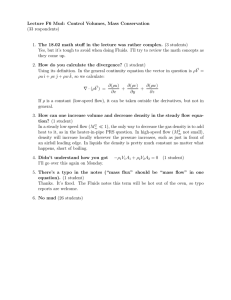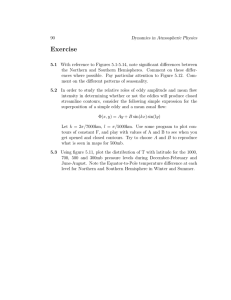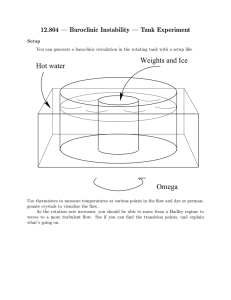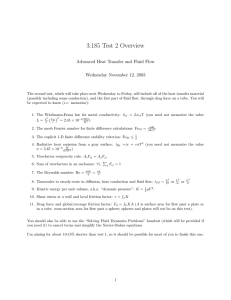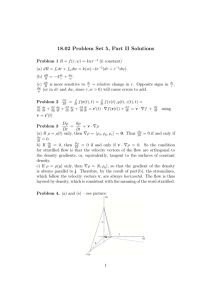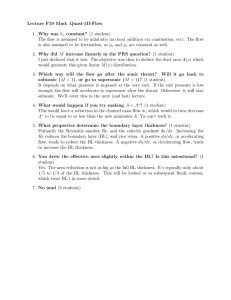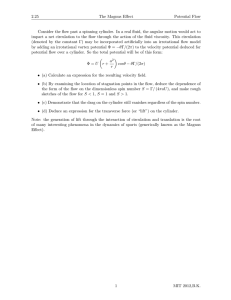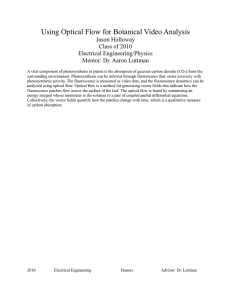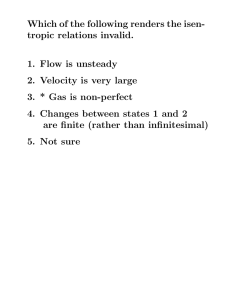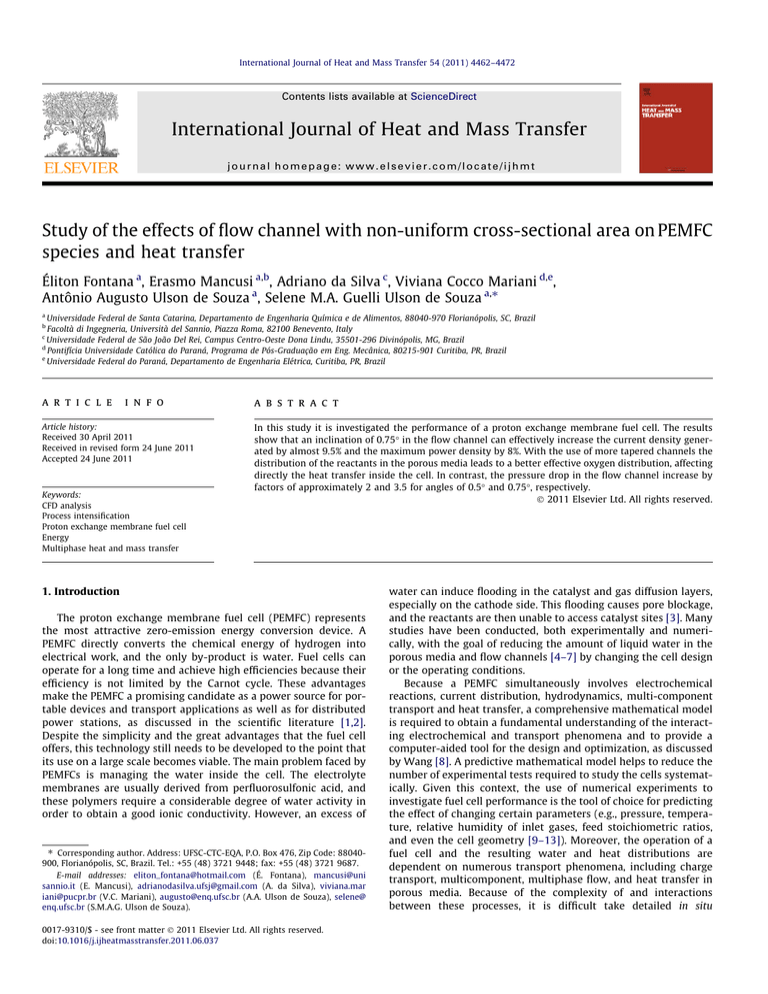
International Journal of Heat and Mass Transfer 54 (2011) 4462–4472
Contents lists available at ScienceDirect
International Journal of Heat and Mass Transfer
journal homepage: www.elsevier.com/locate/ijhmt
Study of the effects of flow channel with non-uniform cross-sectional area on PEMFC
species and heat transfer
Éliton Fontana a, Erasmo Mancusi a,b, Adriano da Silva c, Viviana Cocco Mariani d,e,
Antônio Augusto Ulson de Souza a, Selene M.A. Guelli Ulson de Souza a,⇑
a
Universidade Federal de Santa Catarina, Departamento de Engenharia Química e de Alimentos, 88040-970 Florianópolis, SC, Brazil
Facoltà di Ingegneria, Università del Sannio, Piazza Roma, 82100 Benevento, Italy
Universidade Federal de São João Del Rei, Campus Centro-Oeste Dona Lindu, 35501-296 Divinópolis, MG, Brazil
d
Pontifícia Universidade Católica do Paraná, Programa de Pós-Graduação em Eng. Mecânica, 80215-901 Curitiba, PR, Brazil
e
Universidade Federal do Paraná, Departamento de Engenharia Elétrica, Curitiba, PR, Brazil
b
c
a r t i c l e
i n f o
Article history:
Received 30 April 2011
Received in revised form 24 June 2011
Accepted 24 June 2011
Keywords:
CFD analysis
Process intensification
Proton exchange membrane fuel cell
Energy
Multiphase heat and mass transfer
a b s t r a c t
In this study it is investigated the performance of a proton exchange membrane fuel cell. The results
show that an inclination of 0.75° in the flow channel can effectively increase the current density generated by almost 9.5% and the maximum power density by 8%. With the use of more tapered channels the
distribution of the reactants in the porous media leads to a better effective oxygen distribution, affecting
directly the heat transfer inside the cell. In contrast, the pressure drop in the flow channel increase by
factors of approximately 2 and 3.5 for angles of 0.5° and 0.75°, respectively.
Ó 2011 Elsevier Ltd. All rights reserved.
1. Introduction
The proton exchange membrane fuel cell (PEMFC) represents
the most attractive zero-emission energy conversion device. A
PEMFC directly converts the chemical energy of hydrogen into
electrical work, and the only by-product is water. Fuel cells can
operate for a long time and achieve high efficiencies because their
efficiency is not limited by the Carnot cycle. These advantages
make the PEMFC a promising candidate as a power source for portable devices and transport applications as well as for distributed
power stations, as discussed in the scientific literature [1,2].
Despite the simplicity and the great advantages that the fuel cell
offers, this technology still needs to be developed to the point that
its use on a large scale becomes viable. The main problem faced by
PEMFCs is managing the water inside the cell. The electrolyte
membranes are usually derived from perfluorosulfonic acid, and
these polymers require a considerable degree of water activity in
order to obtain a good ionic conductivity. However, an excess of
⇑ Corresponding author. Address: UFSC-CTC-EQA, P.O. Box 476, Zip Code: 88040900, Florianópolis, SC, Brazil. Tel.: +55 (48) 3721 9448; fax: +55 (48) 3721 9687.
E-mail addresses: eliton_fontana@hotmail.com (É. Fontana), mancusi@uni
sannio.it (E. Mancusi), adrianodasilva.ufsj@gmail.com (A. da Silva), viviana.mar
iani@pucpr.br (V.C. Mariani), augusto@enq.ufsc.br (A.A. Ulson de Souza), selene@
enq.ufsc.br (S.M.A.G. Ulson de Souza).
0017-9310/$ - see front matter Ó 2011 Elsevier Ltd. All rights reserved.
doi:10.1016/j.ijheatmasstransfer.2011.06.037
water can induce flooding in the catalyst and gas diffusion layers,
especially on the cathode side. This flooding causes pore blockage,
and the reactants are then unable to access catalyst sites [3]. Many
studies have been conducted, both experimentally and numerically, with the goal of reducing the amount of liquid water in the
porous media and flow channels [4–7] by changing the cell design
or the operating conditions.
Because a PEMFC simultaneously involves electrochemical
reactions, current distribution, hydrodynamics, multi-component
transport and heat transfer, a comprehensive mathematical model
is required to obtain a fundamental understanding of the interacting electrochemical and transport phenomena and to provide a
computer-aided tool for the design and optimization, as discussed
by Wang [8]. A predictive mathematical model helps to reduce the
number of experimental tests required to study the cells systematically. Given this context, the use of numerical experiments to
investigate fuel cell performance is the tool of choice for predicting
the effect of changing certain parameters (e.g., pressure, temperature, relative humidity of inlet gases, feed stoichiometric ratios,
and even the cell geometry [9–13]). Moreover, the operation of a
fuel cell and the resulting water and heat distributions are
dependent on numerous transport phenomena, including charge
transport, multicomponent, multiphase flow, and heat transfer in
porous media. Because of the complexity of and interactions
between these processes, it is difficult take detailed in situ
É. Fontana et al. / International Journal of Heat and Mass Transfer 54 (2011) 4462–4472
4463
Nomenclature
a
aw
C
cp
cr
Di,m
F
jref
K
kT
M
nd
P
pc
Psat
Pwv
R
Rid
rs
rw
s
Si
SM
SP
ST
T
~
u
V
active surface area [m2]
water activity
molar concentration [mol m3]
specific heat capacity [J kg1 K1]
condensation rate constant [s1]
mass diffusivity of species i in mixture [m2 s1]
Faraday constant [96 485 C mol1]
exchange current density [A m2]
permeability [m2]
thermal conductivity [W m1 K1]
molar mass [kg kmol1]
electro-osmotic drag coefficient
pressure [Pa]
capillary pressure [Pa]
saturation pressure [Pa]
water vapor pressure [Pa]
volumetric transfer current [A m3]
ideal gas constant [8.314 J K1 mol1]
exponent for pore blockage
rate of water condensation [kg s1]
water saturation
source term in species conservation equation
source term in momentum equation
source term in potential equations
source term in energy equation
temperature [K]
velocity vector [m s1]
volume [m3]
measurements. The development of a number of mathematical
models has allowed the collection of detailed information on the
transport mechanisms occurring inside the cell, as cited in [14–
17]. However, the resulting mathematical fuel cell models are in
the form of large sets of highly nonlinear and complex differential
and algebraic equations. One of the challenges in fuel cell modeling
is the use of reliable numerical discretization methods to solve
these governing equations, as reported in Bavarian et al. [18].
The most widely used numerical methods are derived from computational fluid dynamics (CFD). The volume occupied by the fluid
is divided into discrete cells (mesh), and the physical model is defined from the equations of motions, enthalpy and species conservation with appropriate boundary conditions and is solved using
numerical methods.
The use of the CFD code allows the investigation of the influence
of unconventionally shaped flow channels without the need to
build a physical structure, eliminating the manufacture and
machining costs. Yuan et al. [19] analyzed the effects of mass
transfer on the fully developed laminar flow and heat transfer under thermal boundary conditions inside rectangular and trapezoidal channels with different cross-sections. Bunmarck et al. [20]
demonstrated that channel cross-section design alone can improve
PEMFC performance. They also found that a downward-slanted anode channel cell improved the cell performance under extremely
wet conditions and increased the output power to match a cell
without a modified flow channel under less wet conditions. Kuo
and Chen [21] investigated the effects of buoyancy forces in a
wave-like gas flow channel on the velocity, temperature and gas
concentration distributions within the flow channel and on the
electrochemical reaction efficiency and electrical performance of
the PEMFC. In general, the results showed that a wave-like flow
channel improves the maximum power density by approximately
40% over a conventional gas flow channel.
Vcell
VOC
Yi
operation voltage [V]
open circuit voltage [V]
molar fraction of the species i
Greek symbols
a
transfer coefficient
c
exponent for concentration dependence
d
layer thickness
e
porosity
gact
activation overpotential
hc
static contact angle
k
water content
l
viscosity [kg m1 s1]
q
density [kg m3]
r
electric/ionic conductivity [S m1]
rst
surface tension [N m1]
/
phase potential [V]
Superscripts and subscripts
an
anode
cat
cathode
CL
catalyst layer
GDL
gas diffusion layer
L
liquid phase
o, ref
reference value
sol
solid phase
mem
electrolyte phase
The effect of channels with non-uniform cross-sectional areas is
still ill defined and poorly studied. Tapered channels provide a
means of increasing the oxygen concentration at the cathode catalyst layer with the penalty of increasing the pressure drop along
the channel. The inclination angle effect is observed mainly at
low voltages or high current densities, where the consumption of
reactant is higher. Despite significant gains in the current and voltage at high inclination angles, the elevated pressure drop becomes
a restricting parameter, and so an equilibrium point must be found
to optimize the cell performance, as indicated in [22–24].
This study performs numerical simulations to investigate the
effect of flow channels with non-uniform cross-sectional areas on
heat and mass transfer inside the fuel cell. The mass transfer inside
the cell defines the effectiveness of the electrochemical reaction, as
the reactant and product distributions control the reaction rate,
especially at low voltages. Moreover, the temperature distribution
inside the cell has an important impact on the overall performance.
The physical proprieties and transport proprieties of a material,
such as the diffusion coefficients, are dependent on the temperature. Furthermore, the temperature plays a key role in multiphase
transport, defining the rates at which condensation/evaporation
occur.
The model describes a single channel of a PEMFC and differs
from previous models used to investigate similar geometries
[22–24] by implementing a fully three-dimensional (including catalyst layers) geometry with non-isothermal multiphase flow. In
fact, the use of a three-dimensional model allows the evaluation
of many spatial effects that cannot be captured in one or twodimensional models, because they arise from the influence of lateral walls and non-uniformities in the overpotential distribution.
Furthermore, this model accounts for the presence of the anode
side. The main goal of this study is to determine the dependence
of the reactant consumption, power generation and heat transfer
4464
É. Fontana et al. / International Journal of Heat and Mass Transfer 54 (2011) 4462–4472
on the inclination of the flow channel. It is expected that the results
will provide detailed information on the transport phenomena inside the cell, allowing for a better understanding of the reactant
and temperature distributions.
r ðeq~
uÞ ¼ 0
r ðeq~
u~
uÞ ¼ eDP þ r ðelr~
uÞ þ SM
r ðeqcp~
uTÞ ¼ r ðkT rTÞ þ ST
r ðeq~
uY i Þ ¼ r ðDi;m qrY i Þ þ Si
2. Mathematical model
The sources terms in Eqs. (2)–(4) vary according to PEMFC region
evaluated, while the source term in Eq. (4) is also dependent on
the chemical species. All of these terms are summarized in Table 1.
A two-fluid model was used for the multiphase transport,
where the formation and transport of liquid water is governed by:
The basic operating principle of a PEMFC is simple. Hydrogen
is fed to the cell and oxidized at the anode, while oxygen, usually
carried in an air feed stream, is reduced at the cathode. At the anode, hydrogen flows into gas channels and diffuses through a gas
diffusion layer (GDL). Hydrogen then reaches the catalyst layer
(CL), where it is split into electrons and H+ ions through an electrochemical reaction. The electrons flow to the cathode side
through an external circuit, while the protons pass through the
polymer electrolyte membrane. At the cathode, air also arrives
at the CL through the current collector and the GDL. Subsequently, the electrons, H+ ions and oxygen combine to form
water. Each electrode is composed of four layers: a collector plate
that provides mechanical and structural resistance and a path for
the electrons to be conducted outside of the cell, a flow channel
for fluid flow, a gas diffusion layer to distribute the reactant onto
the catalyst layer, and the catalyst layer itself. A 3D view of the
single-channel fuel cell model can be seen in Fig. 1a and b shows
a two-dimensional view.
In developing the model, some assumptions were considered.
In particular, the gas mixture is considered as ideal gas and the
flow is assumed to be steady, incompressible and laminar in the
channel. The gas diffusion layer, catalyst layer and membrane
are all isotropic and homogenous, and are characterized by constant morphological properties, while the contact resistance between the layers is negligible; the liquid velocity inside the
flow channels is approximately equal to the gas velocity, i.e.,
the liquid water inside the flow channels exist only in form of
small droplets (fine mixture); thermal conductivity is constant;
the electrodes are electrically insulated, the leakage current is
null.
2.1. Governing equations for heat and mass transfer
The heat and mass transfer in the PEMFC layers can be modeled
using mass, momentum, energy and species conservation equations, expressed, respectively, as:
usÞ ¼ rw
r ðqL~
ð1Þ
ð2Þ
ð3Þ
ð4Þ
ð5Þ
In the high-resistance porous regions, the capillary diffusion is evaluated instead of the convective term [25]:
r qL
Ks3 dpc
rs
lL ds
!
¼ rw
ð6Þ
The capillary pressure is computed as a function of s, following the
Leverett function for hydrophobic surfaces:
pc ¼
rst cos hc
K 0:5
ð1:417s 2:12s2 þ 1:263s3 Þ
ð7Þ
e
The average values for the temperature and velocity are obtained as
the weighted mean of the variable-specific values in the gas and liquid phases. The physical proprieties for the multiphase flow are
obtained as a linear interpolation between the values for each
phase, except for the diffusion coefficient, calculated in base of reference values as:
Di;m ¼ e1:5 D0i;m ð1 sÞrs
1:5
Po
T
T0
P
ð8Þ
Moreover, the proprieties of the porous media are obtained through
the linear interpolation between the fluid and solid values.
For the water transport in the membrane, other types of mechanisms besides diffusion and convection may exist. The most
important is the electro-osmotic drag, which represents the water
pulled together with H+ ions. An electro-osmotic drag coefficient,
nd, is frequently used to compute the amount of water transported,
as cited in Springer et al. [26]:
nd ¼
2:5
k
22
ð9Þ
Electro-osmotic drag appears as a source term for water transport
in the catalyst layers.
Fig. 1. (a) Three-dimensional and (b) two-dimensional view of the single channel fuel cell model.
4465
É. Fontana et al. / International Journal of Heat and Mass Transfer 54 (2011) 4462–4472
Table 1
Source terms in Eqs. (2)–(4).
Bipolar plate
Flow channel
GDL
Anodic catalyst layer
Cathodic catalyst layer
Membrane
l e~
u
l e~
u
–
SM
–
–
l e~
u
ST
I
rBP þ r w hL
rwhL
I
rGDL þ r w hL
Si
–
–
–
2
K
K
2
K
2
2
I
rCL þ r w hL þ gRan
M H2
2F Ran
n M H O
d F 2 Ran
rmem
MO
H2 : H2 O :
I2
I
rCL þ r w hL þ gRcat
rw
–
O2 : 4F2 Rcat
n M MH O
H O
H2 O : d F 2 Rcat r w þ 2F2 Rcat
Table 2
Physical and geometric parameters used in model.
Parameter
Symbol
Value
Anode inlet gas velocity
Anode inlet relative humidity
Cathode inlet gas velocity
Cathode inlet relative humidity
Anodic charge transfer coefficient
Cathodic charge transfer coefficient
Anode concentration parameter
Cathode concentration parameter
Effective mass diffusivity of oxygen in catalyst layer
Effective mass diffusivity of oxygen in gas diffusion layer
Effective mass diffusivity of hydrogen in catalyst layer
Effective mass diffusivity of hydrogen in gas diffusion layer
Electric conductivity of catalyst layer
Electric conductivity of gas diffusion layer
Electric conductivity of collector plates
Catalyst layer permeability
Gas diffusion layer permeability
Pressure in anode outlet
Pressure in cathode outlet
Porosity of gas diffusion layer
Porosity of catalyst layer
Volumetric reference current density in anode
uin,an
RHin,an
uin,cat
RHin,cat
ajref
an
0.3 [m s1]
100%
0.5 [m s1]
100%
0.5
1.5
1.0
1.0
1.9546 103 [cm2 s1]
1.845 102 [cm2 s1]
0.985 103 [cm2 s1]
0.930 103 [cm2 s1]
135.265 [S m1]
300 [S m1]
4000 [S m1]
1.76 1011 [m2]
1.76 1011 [m2]
1 [atm]
1 [atm]
0.5
0.112
9 108 [A m3]
Volumetric reference current density in cathode
ajcat
an
L
dFC
dGDL
dCL
dmem
0.05 m
0.001 m
3 104 m
1 105 m
1.78 104 m
aan
acat
can
ccat
DO2 ;CL
DO2 ;GDL
DH2 ;CL
DH2 ;GDL
rCL
rGDL
rCP
KCL
KGDL
Pan
Pcat
eGDL
ecat
Gas channel length
Gas channel width
Gas diffusion layer thickness
Catalyst layer thickness
Membrane thickness
The rate of condensation, rw, is obtained as a function of the vapor pressure:
r w ¼ cr max
Pwv Psat
ð1 sÞ
MH2 O ; ðsqL Þ
RT
ð10Þ
Where Psat is the atmospheric saturation pressure, evaluated as:
The source terms in these equations represent the volumetric transfer current and are null in all domains except in the catalyst layers.
For the solid phase, Sp,sol = Ran on the anode side and Sp,sol = Rcat
on the cathode side. For the membrane phase, Sp,mem = Ran on
the anode side and Sp,mem = Rcat on the cathode side. The volumetric transfer current, in each electrode, is obtained with the use of the
Buttler–Volmer model for the kinetics of electrochemical reactions:
log10 Psat ¼ 2:1794 þ 0:02953ðT 273:17Þ
1.0
9:1837 105 ðT 273:17Þ2
þ 1:4454 107 ðT 273:17Þ3
250 [A m3]
ð11Þ
Numerical
Experimental
0.9
The driving force behind the electrochemical reaction is the surface overpotential, which represents the difference between the
phase potential of the solid and electrolyte. To take into account
this difference, two potential equations are solved, one for each
phase. For the solid region (electron conductors), the potential
equation is expressed as:
r ðrsol r /sol Þ ¼ Sp;sol
0.8
0.7
0.6
ð12Þ
and for protonic conductivity (membrane), the potential equation
is:
r ðrmem r /mem Þ ¼ Sp;mem
Voltage (V)
2.2. Governing equations for charge conservation
ð13Þ
0.5
0.0
0.1
0.2
0.3
0.4
0.5
Current Density (A/cm²)
Fig. 2. Comparison between numerical and experimental results [12,28].
4466
É. Fontana et al. / International Journal of Heat and Mass Transfer 54 (2011) 4462–4472
ref
Ran ¼ ajan
ref
Rcat ¼ ajcat
C H2
!can C ref
H2
C H2
C ref
H2
aan F
exp
!ccat exp
RT
aan F
RT
gact;an exp acat F
gact;cat exp RT
gact;an
acat F
RT
gact;cat
ð14Þ
Z
ð15Þ
where gact is the activation overpotential:
gact ¼ /sol /mem V ref
ð16Þ
where the reference voltage, Vref, is 0 V on the anode side and Vref = VOC on the cathode side. The open circuit voltage, VOC, is obtained
following the empirical expression presented by Parthasarathy
et al. [27]:
V OC ¼ 0:0025T þ 0:2329
total current input to the cathode catalyst layer. From a mathematical point of view this condition can be expressed as:
VCL;an
Ran dV ¼
Z
Rcat dV
ð19Þ
VCL;cat
acting as a bridge between the electrodes.
The ionic conductivity of the membrane phase is strongly
dependent on the temperature and water content. For membranes
NafionÒ 110EW, Springer et al. [26] presented the correlation
through which to evaluate the ionic conductivity (S/m), in the
range of temperature between 20 °C and 90 °C:
rm ¼ ð0:5193k 0:326Þ exp 1268
1
1
303 T
ð20Þ
ð17Þ
where the water content is given by:
The cell operation voltage is the difference between the electric potential in each electrode:
V cell ¼ /sol;cat /sol;an
ð18Þ
To ensure the electron conservation, the current over the whole catalytic layer has to be equal for the two electrodes, that is, the total
current output from the anode catalyst layer must be equal to the
k ¼ 0:043 þ 17:18aw 39:58aw2 þ 36aw3
ðaw < 1Þ
k ¼ 14 þ 1:4ðaw 1Þ ðaw > 1Þ
ð21Þ
ð22Þ
and the water activity is defined as:
aw ¼
Y H2 O P
þ 2s
Psat
ð23Þ
3. Numerical methodology
The set of equations previously presented are numerically
solved using the commercial CFD software ANSYS FluentÒ 13.0.
The software uses the finite volume method to numerically solve
the mathematical model. To speed up the convergence, an algebraic multigrid method is used, then the solution is computed on
more than one grid level, removing errors of high and low frequencies. The solution procedure is based on the SIMPLE method to
solve the pressure–velocity coupling, and a second order upwind
method was employed as the interpolation function. For the multigrid formulation, the F-cycle with bi-conjugate gradient stabilized method (BCGSTAB) is used. The maximum number of cycles
is set to 60, with one pre-sweep and two post-sweep steps. Appropriate under-relaxation factors are used for each variable to ensure
a stable convergence.
The governing equations are discretized under a structured
mesh representing the nine-layer model. Since the geometry is
no complex, only hexahedral elements are used. To evaluate the
number of elements required, four different meshes were tested
Fig. 3. Molar oxygen for three angles (hFC) at the center of the cathodic gas-diffusion
layer for (a) V = 0.75 V and (b) V = 0.5 V.
Fig. 4. Fraction of oxygen consumed for three channel angles.
É. Fontana et al. / International Journal of Heat and Mass Transfer 54 (2011) 4462–4472
in a geometry with hFC = 0° and no significant changes are observed
for a mesh with more than 24 72 250 elements even for the
cases where hFC = 0°, the same mesh configuration was used and
the number of elements for each layer remained the same.
4467
Although, due to the inclination of the channel, the elements in this
layer have a non-uniform shape.
The numerical method is validated comparing the results
obtained numerically with experimental data presented in the
Fig. 5. Oxygen molar concentration for V = 0.75 V (a) along the cell and (b) at the cathode GDL–catalyst layer interface.
Fig. 6. Oxygen molar concentration along the cell for V = 0.5 V.
4468
É. Fontana et al. / International Journal of Heat and Mass Transfer 54 (2011) 4462–4472
literature [12,28]. The parameters and the boundary condition values were chosen according to the experimental procedure defined
in [12,28] and reported in Table 2.
The polarization curves obtained by numerical simulation and
experimentally are shown in Fig. 2. The numerical results are in
agreement with the experimental results, indicating the consistency of the numerical methodology for the entire current density
range. Even for high current density, when the presence of liquid
water is usually more significant, the numerical results of the
proposed mathematical model are in good agreement with the
experimental data.
4. Results
Spatial oxygen and temperature profiles, polarization and
power curve data are presented to elucidate the effect of different
Fig. 7. Temperature [K] distribution inside the cell for (a) hFC = 0° and (b) hFC = 0.75° (V = 0.75 V), (c) hFC = 0° and (d) hFC = 0.75° (V = 0.5 V). Upper part represents the anode and
bottom part the cathode.
Fig. 8. Gaseous water molar concentration at various planes along the channel for V = 0.5 V and (a) hFC = 0° and (b) hFC = 0.75°. Upper part represents the anode and bottom
part the cathode.
É. Fontana et al. / International Journal of Heat and Mass Transfer 54 (2011) 4462–4472
Fig. 9. Water activity at mid-plane of membrane for V = 0.5 V and (a) hFC = 0°, (b) hFC = 0.5° and (c) hFC = 0.75°.
flow channel patterns on the PEMFC performance. To examine this
effect the parameter hFC, which define the flow channel slope, is
varied between 0° (rectangular flow channels), 0.5° and 0.75°.
These approximately, correspond to a ratio between inlet and outlet cross-sectional area of 0.6 and 0.35, respectively. Finally, the effect of tapered channels on the pressure drop on the cathode side
was addressed, which is a key parameter in terms of the PEMFC
maintenance cost. The parameters are reported in Table 2 and
the feed and operation temperature was 353 K.
4.1. Oxygen and temperature distributions
For design and operational purposes a deep understanding of
the distribution of the limiting reactant (oxygen) at the interface
between the GDL and the catalyst layer is crucial.
In Fig. 3 the oxygen concentration profiles at the center of the
cathodic gas-diffusion layer are presented for the three channel angles and for two different cell voltages. In both cases it is clear that
the oxygen concentration decreases along the flow direction. Nevertheless, close to the entrance of the flow channel the differences
between rectangular and tapered flow channels are slight. Moreover, the overall voltage has the effect of increasing the differences
between the tapered and rectangular sections. It is important to
note that, since the electrochemical reaction becomes stronger as
the current density increase the overall amount of oxygen is aspect
to increase when the voltage increases. For the higher voltage value, 0.75 V (see Fig. 3a), the concentration polarization is not the
predominant form of voltage loss, so despite the great gain in oxygen concentration at the catalyst layer, the increase in current density is slight (near 2.5%). For the lower voltage value (0.5 V Fig. 3b),
the drop in oxygen concentration along the flow direction (Z) is
more significant and in this case the process that limits the current
generation is basically the amount of oxygen that reaches the catalyst layer. For this case, the increase in current density is more
significant (5.6% for hFC = 0.5° and 9.4% for hFC = 0.75°).
The effect of the cell voltage on the ratio between the oxygen
feed and that leaving the cell is shown in Fig. 4 for three different
flow channel angles. As can be seen, the oxygen conversion is almost 5.15% greater for the channel with hFC = 075° in comparison
Fig. 10. Polarization curves for various flow channel angles.
Fig. 11. Power curve for various flow channel angles.
4469
4470
É. Fontana et al. / International Journal of Heat and Mass Transfer 54 (2011) 4462–4472
with the straight channel (hFC = 0°) for the voltage of 0.75 V (point
of maximum power generation) and 8.5% for the voltage of 0.5 V.
On the other hand, for the channel with hFC = 0.5°, the increase is
less pronounceable, but still significant, with a relative value of
approximately 3.5% for a voltage of 0.75 V and 5.25% for 0.5 V.
Thus, tapering the flow channel allows a higher reactant conversion to be achieved. Similarly, the same conversion that a rectangular channel allows can be achieved in a shorter cell with a tapered
flow channel. This result is of great significance considering that
practical devices are comprised of a stack of many cells.
A global view of the effect of the flow channel design on the
oxygen distribution can be seen in Fig. 5a, where the three dimensional oxygen profiles are represented, while in Fig. 5b the oxygen
distribution at the interface between the GDL-catalyst layer is represented for the same voltage values. It is apparent that the main
differences between rectangular and tapered flow channels appear
close to the outlet section, while at the inlet the effect of the
tapered channel is less evident. For the rectangular channels the
amount of oxygen is very low close to the outlet section, particularly near the walls. This may affect the overall current production,
causing an ineffective region where the current generation is too
small. The area with lean oxygen becomes smaller and smaller as
the channel depth decreases. Therefore, in the tapered gas channel
the oxygen can accelerate and is forced into the catalyst layer
improving the cell performance.
A similar phenomenon can be observed for a lower potential value, as reported in Fig. 6. Finally, it should be noted that the effect
of hFC on the oxygen distribution is less marked along the sections
perpendicular to the flux.
Fig. 7 shows the temperature distribution inside the cell for a
rectangular cell (Fig. 7a and c) and a tapered cell (hFC = 0.75°
Fig. 7b and d) for two voltage values. It is apparent that the differences between rectangular and tapered channels are significant
only in the cathode side of the cell, mainly at the interface between
the gas-diffusion layer and the catalyst layer. On the anode side,
changing the depth of the flow channel does not affect the temperature distribution in the anodic region significantly. In fact, the
temperature distribution is directly affected by the oxygen distribution, since the reaction heating is predominantly related to the
ohmic heating and the thermal conductivity of the gas diffusion
layer is greater than the membrane conductivity. For high voltage
(0.75 V) there is a slight difference between the rectangular and tapered channels as can be seen in Fig. 7a and b. In fact, for both
cases the temperature distribution is quite similar in all planes
and does not vary significantly along the cells, therefore the heat
is generated uniformly. On the other hand, at lower voltage
(0.5 V) the differences are marked (Fig. 7c and d). As discussed
above, the oxygen availability at the catalyst layer increases as
the depth of the flow channel decreases leading to a higher heat
production. This is more evident as the gas approaches the outlet
section of the cell.
4.2. Water management
The fuel cell literature contains extensive studies which demonstrate that PEM cells only operate when sufficient water is present
in the membrane. Moreover, to ensure the durability of the PEMFC,
it is important that the membrane remains with the maximum
humidity possible, which allow the ions H+ to be more effectively
conducted and prevents damage to the membrane. Water is the
reaction product in the PEMFC, and it autocatalytically accelerates
the reaction rate by enhancing proton transport through the PEM.
On the other hand, the water flooding of the cell caused by improper water removal may also result in mass transport loss due to the
blockage of the reaction sites. Appropriate designing of the flow
channels should provide a means to remove the water generated
at the cathode catalyst layer and thus prevent the gas diffusion
layer from flooding.
The gaseous water concentration at various planes along the
cell is shown in Fig. 8 for a voltage of 0.5 V and for two different
channel angles, hFC = 0° (Fig. 8a) and hFC = 0.75° (Fig. 8b). In both
cases, the water molar concentration is lower in the anode side
since the back diffusion is not sufficient to equilibrate the water
content. A region with higher water concentration appears at the
center of the catalyst layer, where the reaction occurs at a higher
rate. Particularly in the case with hFC = 0°, the water molar concentration in this region decreases considerably along the flow direction due to the reduction in oxygen concentration in comparison
Fig. 12. Overpotential at the center of cathode catalyst layer for V = 0.5 V and (a) hFC = 0°, (b) hFC = 0.5° and (c) hFC = 0.75°.
É. Fontana et al. / International Journal of Heat and Mass Transfer 54 (2011) 4462–4472
with the case of hFC = 0.75°. As can be seen in the figure, the increase in the inclination angle cause a slight increase in the water
concentration in the region near the outlet. This increase reflects
the better oxygen distribution (and therefore greater water production) and variations in temperature and pressure conditions.
Nevertheless, the increase in the water mass fraction at the cathode outlet for the channel with hFC = 0.75° in relation to the straight
channel is only around 2%.
Fig. 9 shows the water activity (Eq. (23)) evaluated at the midplane of the electrolyte membrane for a voltage of 0.5 V, for the
three angles analyzed. The average values for the three cases are
very similar, but the water activity distribution, especially in the
central region, has a great influence on the channel inclination angle. For all cases, a region with aw > 1 can be observed, indicating
the presence of liquid water, which is more evident for hFC =
0.75°. The ionic conductivity of the membrane is highly favored
by the presence of liquid water. The region near the lateral walls
shows considerably less water activity, result of the influence of
the current collector plates, which is significant even at the midplane of the cell. This shows that the mass flow in the porous media is much higher in the y direction than in x direction.
4.3. Fuel cell performance
To investigate the global performance of the fuel cells, the
polarizations and power curves are reported for three values of
the parameter hFC. The polarization curves provide information
on the voltage loss as a function of the current density. For low current density we can observe a region where the loss is almost only
because of the activation overpotential, while for larger current
density values the mass transport is the principal restriction to
electric current generation. The power curves reveal the total
amount of power generated by the cell.
In Fig. 10 the polarization curves for the three different angles
are reported. As can be observed, the influence of the non-uniform
channel is significant only for high current densities, where the
current generation is limited by the amount of reactant available
in the catalyst layer, especially the amount of oxygen in the cathode catalyst layer. As discussed in Section 4.1, the channel inclination increases the fluid velocity and forces it to enter the gas
diffusion layers with greater pressure, increasing the reactant concentration. For the angle of 0.75°, a maximum increase of almost
9.5% is achieved, while for the inclination of 0.5% the maximum increase is almost 5.65%. In both cases, this maximum value corresponds to the lower voltage (higher current density). As the
voltage increases the gain in current density asymptotically tends
toward zero.
In Fig. 11 the power curves for the three cases are shown. The
maximum power generation is not for the greater current densities, but rather the curve shows a maximum point for an intermediate value, that is, for a voltage of around 0.65–0.60 V. For this
reason it is no necessary evaluate the fuel cell performance for
voltages lower than 0.5, since this condition will result in a maximum power generation which is less than that at the maximum
point. At the point of maximum power generation, the relative
increase in relation to the fuel cell with a uniform flow channel
is around 8% for hFC = 0.75° and only 4% for hFC = 0.5°.
The voltage loss that appears on the polarization curves in due
to the occurrence of overpotential in the cell operation, particularly
that related to the reaction activation, ohmic losses and concentration polarization. During operation at higher current densities, almost all voltage loss occurs at the cathode catalyst layer, since
the oxygen reaction is the limiting process. In Fig. 12 the overpotential distribution at the center of the cathode catalyst layer is
shown for the three flow channel angles investigated, with a voltage of 0.5 V. It is important to note that the overpotential in our
4471
formulation is negative at this location, so a lesser value (greater
in modulus) represents a greater voltage loss and consequently a
poorer performance. As can be seen in the figure, the area above
the region where the gas diffusion layer is in contact with the collector plates presents a greater voltage loss and in the center, especially near the inlet, a lesser absolute overpotential is observed.
Furthermore, the increase in channel angle reduces the voltage loss
near the outlet. The overpotential distribution is quite similar to
the oxygen distribution, because, in this case, the concentration
polarization is the predominant form of voltage loss and thus regions with low oxygen concentration will induce a large voltage
loss.
4.4. Velocity distribution and pressure drop
The change in the channel shape analyzed in this study was proposed as a mean to increase the fluid velocity in the flow channel
without an excessive energy requirement. As previously described,
the increase in channel velocity leads to better reactant transport
at the gas diffusion layer increasing considerably the oxygen concentration at the cathode catalyst layer. Fig. 13a shows the velocity
profiles at the center of the cathode flow channels for channel angle values. Close to the inlet the flow is not fully developed, therefore no difference between the rectangular and tapered channel
Fig. 13. (a) Velocity profiles at center of cathode flow channel and (b) relative
pressure profiles along the center of cathode flow channel.
4472
É. Fontana et al. / International Journal of Heat and Mass Transfer 54 (2011) 4462–4472
appears. As the gas flows inside the channel the effect of the depth
becomes more evident. In fact, for hFC = 0° the velocity slightly decreases due to the oxygen consumption while for the other cases,
the area reduction makes the velocity increase rapidly along the
flow direction.
The pressure drop on the cathode side is a key operating parameter to consider in relation to the fuel cell efficiency. This effect was
investigated thought Fig. 13b where the pressure drop at the cathode side is reported for three angle values. Decreasing the depth of
the channel leads to an increase in the pressure drop. To be more precise, for the rectangular channel the pressure drop is approximately
10.5 Pa, and for the channel with hFC = 0.5°, the pressure drop is
twice this value, reaching approximately 21 Pa. For hFC = 0.75° the
increase is more significant, that is, to approximately 3.5 times the
value obtained for the straight channel (36 Pa).
5. Conclusions
In this study, a completely three-dimensional model was used
to investigate the effects of non-uniform cross-sectional area flow
channels on the performance of a PEMFC. This model allows the
influence of lateral walls and non-uniformity in the overpotential
distribution to be evaluated, since this cannot be computed by a
simple two-dimensional model. The numerical results were reported for three different flow channel angles of inclination, that
is, hFC = 0°, 0.5° and 0.75°. Through the construction of polarization
curves, a maximum gain in current density of almost 9.5% for
hFC = 0.75° and a voltage of 0.5 V was found, while for hFC = 0.5°
the gain for the same voltage was approximately 5.65%. The flow
channel design evaluated acts on the reactant distribution, increasing the oxygen concentration at the cathode catalyst layer. For this
reason, the increase in cell current density is more pronounced for
low voltages, when the concentration polarization has a greater
impact. The main disadvantage of the use of non-uniform channels
is the pressure drop increase. For hFC = 0.75° the pressure drop
increased by a factor of almost 3.5 times, while for hFC = 0.5° this
reduced to a factor of two.
Acknowledgements
The authors are grateful to the National Petroleum Agency
(ANP), through the project PRH009 (MECPETRO), and to CNPq (processes: 504102/2009-5) for its financial support.
References
[1] P. Corbo, G. Migliardini, O. Veneri, Experimental analysis of a 20 kWe PEM fuel
cell system in dynamic conditions representative of automotive applications,
Energy Conversion and Management 49 (2008) 2688–2697.
[2] D. Ramirez, L.F. Beites, F. Blazquez, J.C. Ballesteros, Distributed generation
system with PEM fuel cell for electrical power quality improvement,
International Journal of Hydrogen Energy 33 (2008) 4433–4443.
[3] K. Jiao, X. Li, Water transport in polymer electrolyte membrane fuel cells,
Progress in Energy and Combustion Science 37 (2011) 221–291.
[4] H. Kim, J.H. Nam, D. Shin, T.Y. Chung, Y.G. Kim, A numerical study on liquid
water exhaust capabilities of flow channels in polymer electrolyte membrane
fuel cells, Current Applied Physics 10 (2010) S91–S96.
[5] D. Gerteisen, T. Heilmann, C. Ziegler, Enhancing liquid water transport by laser
perforation of a GDL in a PEM fuel cell, Journal of Power Sources 177 (2008)
348–354.
[6] J.H. Nam, K.J. Lee, G.S. Hwang, C.J. Kim, M. Kaviany, Microporous layer for water
morphology control in PEMFC, International Journal of Heat and Mass Transfer
52 (2009) 2779–2791.
[7] T.A. Trabold, J.P. Owejan, D.L. Jacobson, M. Arif, P.R. Huffman, In situ
investigation of water transport in an operating PEM fuel cell using neutron
radiography: Part 1 – Experimental method and serpentine flow field results,
International Journal of Heat and Mass Transfer 49 (2006) 4712–4720.
[8] Y. Wang, Fundamental models for fuel cell engineering, Chemical Reviews 4
(2004) 4727–4766.
[9] W. Yuan, Y. Tang, M. Pan, Z. Li, B. Tang, Model prediction of effects of operating
parameters on proton exchange membrane fuel cell performance, Renewable
Energy 35 (2010) 656–666.
[10] H.Y. Park, J.W. Hwang, K.T. Park, S. Kim, Y.U. Jeong, H.W. Jung, S.H. Kim, Effect
of process conditions on dynamics and performance of PEMFC: comparison
with experiments, Thin Solid Films 518 (2010) 6505–6509.
[11] M.G. Santarelli, M.F. Torchio, Experimental analysis of the effects of the
operating variables on the performance of a single PEMFC, Energy Conversion
and Management 48 (2007) 40–51.
[12] C.H. Cheng, H.H. Lin, G.J. Lai, Design for geometric parameters of PEM fuel cell
by integrating computational fluid dynamics code with optimization method,
Journal of Power Sources 165 (2007) 803–813.
[13] A. Su, Y.M. Ferng, J.C. Shih, CFD investigating the effects of different operating
conditions on the performance and the characteristics of a high-temperature
PEMFC, Energy 35 (2010) 16–27.
[14] D.H. Scharwz, S.B. Beale, Calculations of transport phenomena and reaction
distribution in a polymer electrolyte membrane fuel cell, International Journal
of Heat and Mass Transfer 52 (2009) 4047–4081.
[15] J.J. Hwang, P.Y. Chen, Heat/mass transfer in porous electrode, International
Journal of Heat and Mass Transfer 49 (2006) 2327–2351.
[16] Y. Wang, S. Cho, R. Thiedmann, V. Schmidt, W. Lehnert, X. Feng, Stochastic
modeling and direct simulation of the diffusion media for polymer electrolyte
fuel cells, International Journal of Heat and Mass Transfer 53 (2010) 1128–
1138.
[17] I.B. Sprague, P. Dutta, Modeling of diffuse charge in a microfluidic based
laminar flow fuel cell, Numerical Heat Transfer: Part A 59 (2011) 1–27.
[18] M. Bavarian, M. Soroush, I.G. Kevrekidis, J.B. Benzinger, Mathematical
modelling steady-state and dynamic behavior, and control of fuel cells: a
review, Industrial and Engineering Chemistry Research 49 (2010) 7922–
7950.
[19] J. Yuan, M. Rokni, B. Sundén, Simulation of fully developed laminar heat and
mass transfer in fuel cell ducts with different cross-sections, International
Journal of Heat and Mass Transfer 44 (2001) 4047–4058.
[20] N. Bunmarck, S. Limtrakul, M.W. Fowler, T. Vatanatham, J. Gostick,
Assisted water management in a PEMFC with modified flow field and
its effect on performance, International Journal of Hydrogen Energy 35
(2010) 6887–6896.
[21] J.K. Kuo, C.K. Chen, The effects of buoyancy on the performance of a PEM fuel
cell with a wave-like gas flow channel design by numerical investigation,
International Journal of Heat and Mass Transfer 50 (2007) 4166–4179.
[22] H.C. Liu, W.M. Yan, C.Y. Soong, F. Chen, H.S. Chu, Reactant gas transport and
cell performance of proton exchange membrane fuel cells with tapered flow
field design, Journal of Power Sources 158 (2006) 78–87.
[23] Z. Zhenzhong, C. Junxun, Z. Pingji, Enhancement of proton exchange
membrane fuel cell performance using a novel tapered gas channel, Chinese
Journal of Chemical Engineering 17 (2) (2009) 286–297.
[24] S.W. Perng, H.W. Wu, Non-isothermal transport phenomenon and cell
performance of a cathodic PEM fuel cell with a baffle plate in a tapered
channel, Applied Energy 88 (2011) 52–67.
[25] FluentÒ 13.0 Documentation, Fluent Inc., 2010.
[26] T.E. Springer, T.A. Zawodzinki, S. Gottesfeld, Polymer electrolyte fuel cell
model, Journal of Electrochemical Society 141 (1994) 1493–1498.
[27] A. Parthasarathy, S. Srinivasan, A.J. Appleby, C. Martin, Temperature
dependence of the electrode kinetics of oxygen production of the platinum/
Nafion interface – a microelectrode investigation, Journal of Electrochemical
Society 139 (1992) 2530–2537.
[28] C.H. Cheng, H.H. Lin, G.J. Lai, Numerical prediction of the effect of catalyst layer
Nafion loading on the performance of PEM fuel cells, Journal of Power Sources
164 (2007) 730–741.

